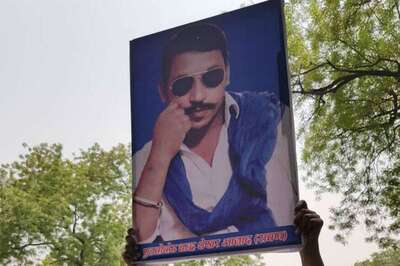
views
Cairo: Two days of street battles between security forces and protesters in Cairo show just how volatile Egypt remains nearly five months after the popular uprising that ousted authoritarian leader Hosni Mubarak.
More than 1,000 people were hurt in the unrest on Tuesday and Wednesday, driven by discontent over the slow pace of justice for old regime figures accused of corruption and killing protesters.
The clashes in Tahrir Square - the worst since the 18-day uprising - add a new layer to an already painful and chaotic transition from Mubarak's regime to democratic rule under the supervision of the military.
The violence will likely set back efforts to empower the discredited police to fully take back the city's crime-ridden streets after they melted away during the early days of the Jan. 25 to Feb. 11 uprising.
Additionally, it will almost certainly deepen the distrust felt by many Egyptians toward the 500,000-strong security forces blamed for the worst human rights abuses during Mubarak's 29-year rule.
Gigi Ibrahim, one of the protesters, said security forces rained tear gas on demonstrators this week.
"It was like January 25 again," she said. "The protesters have enough anger, either because change has not come or because the Supreme Council of the Armed Forces hasn't done enough" to meet their demands.
In Washington, U.S. State Department spokesman Mark Toner said the latest unrest "underscores the fact that this is a very difficult period for Egypt."
"It's a period of transition and we remain committed to assisting the people of Egypt as they make their way through this period of democratic transition," Toner said. "Transparency and rule of law are absolutely crucial and violence by any party will not help achieve the goals of the January 25 revolution."
In addition to discontent over serving justice to Mubarak and stalwarts of his regime, the country is plagued by a dramatic surge in crime and divided by a debate on whether a new constitution should be drafted before or after parliamentary elections due later this year.
Many Egyptians also fear that Islamists are poised to dominate the country, taking advantage of the weakness of liberal and leftist groups born out of the uprising. Others are worried that remnants of Mubarak's regime are undermining the nation.
The ruling military issued a statement on its Facebook page asserting the clashes were designed to "destabilize the country" and drive a wedge between the opposition and security forces. It called on Egyptians not to join the protests.
Security officials said at least 30 protesters were arrested and were being questioned by military interrogators. They spoke on condition of anonymity because they were not authorized to speak to the media.
The clashes had an immediate impact on the country's stock market, whose benchmark index tumbled 2 percent Wednesday.
Riot police fanned out around the Interior Ministry building in Cairo's downtown area and fired in the air or used tear gas as demonstrators threw rocks and firebombs. The fighting left streets littered with rocks and debris. A heavy, white cloud of tear gas hung over the area.
By late afternoon, army troops backed by armored vehicles took over from riot police, closing all roads leading to the Interior Ministry complex, the official Middle East News Agency, MENA, reported.
Ihab el-Manharawi, a 27-year-old protester injured in the January protests, said this week's violence reminded him of the deadly clashes with security forces earlier this year.
"When I saw that, I didn't care. ... I joined the protesters," he said. "The same old tactics ... People have changed, but they haven't. We wanted to believe it for a while, but the mindset (of Egypt's current leaders) is still the same. These people must leave."
More than 1,000 people were injured, MENA quoted Assistant Health Minister Abdul-Hameed Abazah as saying. About 900 were treated at the scene and more than 120 went to hospitals. Most of the injured suffered from gas inhalation, cuts, bruises and concussions, he said. At least 18 cars and 11 stores were damaged.
Ambulances, cars and motorbikes ferried the wounded to hospitals, while volunteer doctors and nurses treated others on the sidewalks.
Some protesters used scarves to shield their faces from tear gas. They pelted police cars with rocks and advanced when the riot police lines retreated. The main chant back in January and February - "the people want to oust the regime!" - was replaced by screams of "the people want to oust the field-marshal," a reference to Mohammed Hussein Tantawi, Mubarak's longtime defense minister and chairman of the Supreme Council of the Armed Forces that has taken over.
Some of the youth groups behind the uprising see Tantawi as tainted because he was a key member of the Mubarak regime. Critics also charge that Tantawi's policies are designed to keep the old order, and accuse him of deliberately stalling the process of purging Mubarak loyalists and failing to reform the Interior Ministry and its security agencies.
Mubarak's security chief, former Interior Minister Habib el-Adly, is on trial along with several of his top aides for ordering the use of deadly force against protesters. This week, his trial was adjourned until July 25, a decision that touched off clashes between relatives and police outside the courthouse. Some of the victims' relatives want Mubarak to be included in the case against el-Adly.
Mubarak has been under arrest at a hospital in the Red Sea resort city of Sharm el-Sheikh and has been charged with ordering the killing of protesters. Both men face the death penalty if convicted. Mubarak and his two sons go on trial Aug. 3.
The clashes began Tuesday evening after security forces refused to allow about 100 people to attend a ceremony at a Nile-side theater to honor the memory of people killed in the uprising. Many in the crowd said they were relatives of victims and fought with police to gain entry, pelting the theater with rocks.
The crowd then headed across the river to the state television building, where they persuaded relatives of victims staging a sit-in there to join the protest. Together, they marched to the Interior Ministry, where they clashed with police and later headed to nearby Tahrir Square.
They battled the police again until authorities ordered the police to pull back.
There were an estimated 6,000 protesters at the peak of the riots late Tuesday.
Wednesday's clashes centered on streets leading to the Interior Ministry close to the downtown campus of the American University in Cairo.
Tahrir Square was closed to traffic for most of the day and about 1,500 protesters remained out on the streets.


















Comments
0 comment